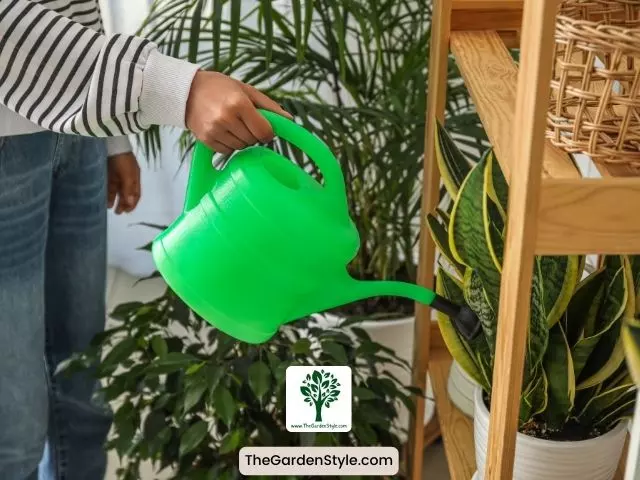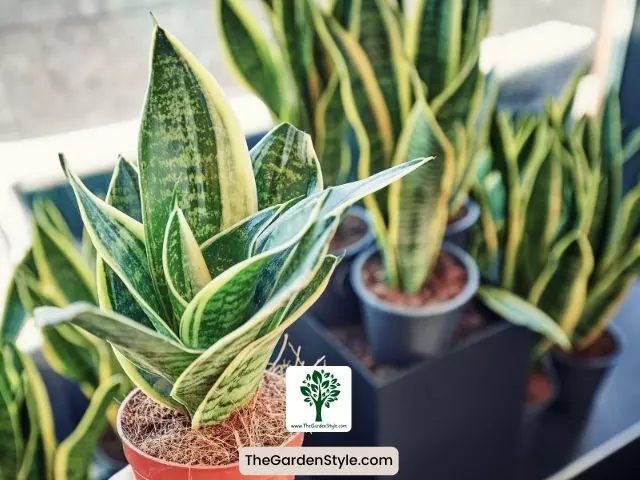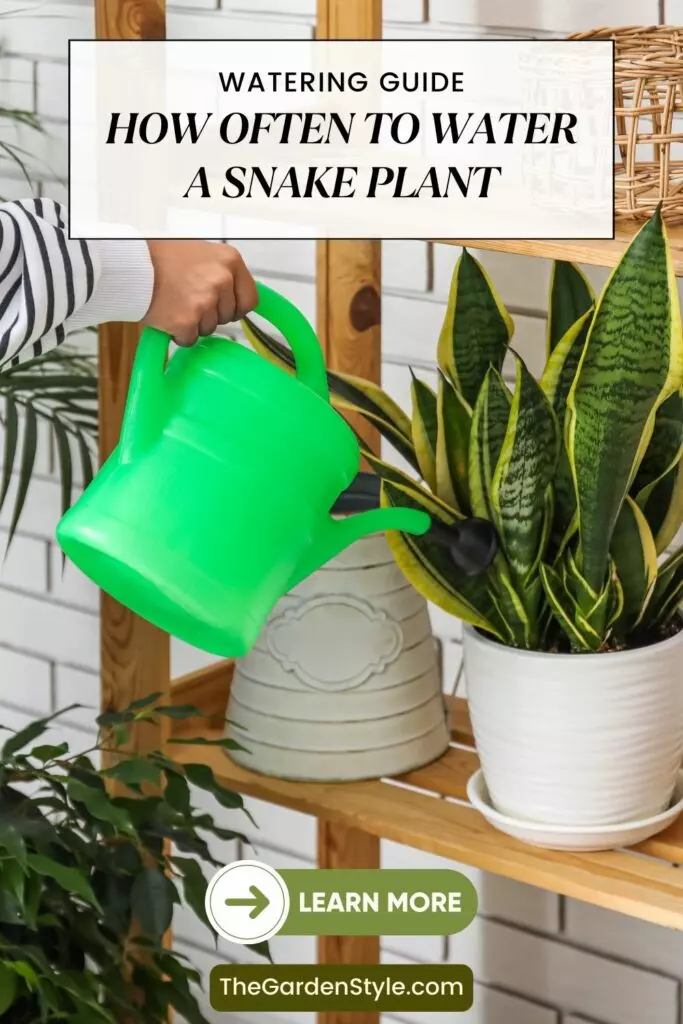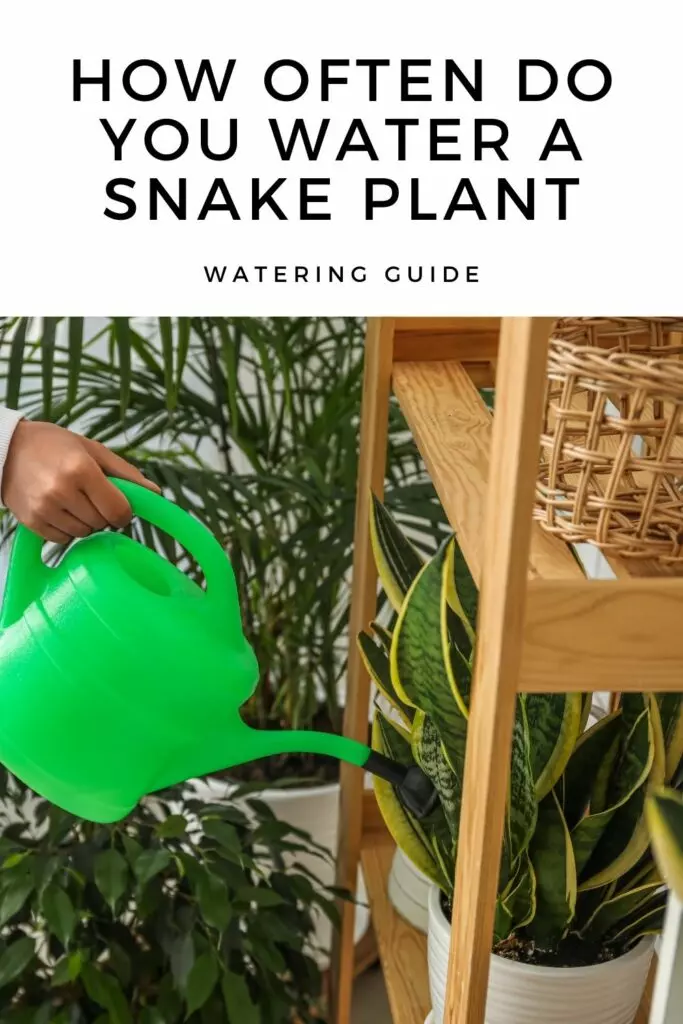Are your snake plants looking a little limp and lackluster? Before you reach for the watering can again, stop! Overwatering is the number one killer of these low-maintenance succulents that are so popular in homes and offices. Knowing exactly how often to water a snake plant is the key to keeping them thriving for years to come.
In this post, we’ll dig into how much and how often to water that precious Sansevieria on your shelf. You’ll learn to read its subtle signs of distress and discover its secret season of growth. Arm yourself with the insider snake plant watering schedule that only the most green-thumbed gardening pros know. Once you’re tuned in to what your snake plant needs and when, you’ll have the formula to grow lush, upright leaves year-round – with minimal effort on your part!
Table of Contents
How Much Water Do Snake Plants Need?
Snake plants differ from many other houseplants in that they prefer arid conditions. Too much moisture can actually harm them and lead to root rot. The most fundamental rule of snake plant care when it comes to watering is to allow the soil to completely dry out before watering again.
There are a few key factors that determine precisely how much water your snake plant needs:
Climate: Snake plants in warmer, more humid environments will need slightly more frequent watering than those in cooler, drier areas. Adjust watering based on your local conditions.
Pot Size & Drainage: Soil dries out faster in smaller pots, while larger pots retain moisture longer. Make sure your pot has drainage holes as well.
Plant Size: Larger plants with extensive root systems use more water than smaller, younger snake plants. Water more established plants a bit more often.
Soil Type: Well-draining potting mixes designed for cacti and succulents are ideal, as they dry out rapidly. Denser soils with lots of peat moss take longer to dry. Learn more about the best soil for a snake plant.
The most foolproof way to assess your snake plant’s water needs is to use the “look and feel” method, judging its thirst by the moisture in the soil and visible signs from the plant itself instead of sticking to a fixed schedule. Excessive watering can cause yellow leaves on the snake plant. I recommend you to read our article snake plant leaves turning yellow: causes and solutions.

Signs Your Snake Plant Needs Water
Figuring out just how often to water any houseplant can be tricky. Still, snake plants make it easier by displaying some clear visual and tactile clues when they’re thirsty:
Drooping or Curling Leaves: When a snake plant needs water, you may notice its leaves drooping over or curling downwards slightly at the tips. That is one of the most telling indicators to reach for the watering can.
Totally Dry Soil: Stick your finger into the potting mix or use a small trowel to peek at the soil. If it’s completely dried out all the way through, not just on top, it’s safe to water your snake plant.
Lightweight Pot: Pick up your snake plant’s pot to gauge its weight. When the soil is dried, the pot will feel significantly lighter and much easier to lift. That is a foolproof sign your plant would appreciate some hydration.
Wrinkled Leaves: Along with drooping, the elongated, pointed leaves of a thirsty snake plant may appear wrinkled, puckered, or slightly deflated rather than nice and plump.
Once you notice several of these signs, it is safe to thoroughly water your snake plant until the soil is evenly moistened. The next crucial step is to allow the soil to completely dry out before repeating the process. Getting the watering frequency right prevents overwatering.
How Often Do You Water a Snake Plant
Using the visual clues and soil dryness as your guide, here are some general benchmarks for how often to water a snake plant:
Spring and Summer: During the warmer months of vigorous growth, most snake plants need water just once or twice a month. For example, water whenever the soil has been completely dry for 1-2 weeks.
Fall and Winter: As light and temperatures dip in the cooler months, scale back to only watering about once per month when the soil is totally dry. The plants grow more slowly and require less moisture.
If your snake plant does not show multiple signs of needing water after what seems like the regular interval, resist the urge to water just because it seems like it should be time. Err on the side of less frequent watering with these drought-tolerant plants.
My gardening tip for you is to pay close attention in the beginning to learn your plant’s needs. Thoroughly soaking the soil periodically instead of frequent light watering produces the most vigorous snake plant growth. And with proper dry spells in between, you’ll prevent dreaded root rot in your snake plant!

Watering Best Practices
When you determine it’s time to water your snake plant, follow these simple tips for providing moisture most effectively:
Water Thoroughly: When watering, continue pouring consistently at the base of the plant until you see drainage flowing out the bottom of the pot. Thorough soaking allows moisture to penetrate all the way into the root zone.
Water at the Soil: Carefully pour water directly into the potting mix, taking care not to splash the leaves and crown of the plant if possible. Target the soil surface rather than spraying foliage.
Empty Drainage: If your snake plant is in a decorative cachepot without drainage holes, empty out any drainage water accumulated in the saucer so the pot itself is not left sitting in water, preventing soggy soil.
Avoid allowing excess moisture to linger around your snake plant’s roots between more arid cycles. Following these straightforward practices when you do water maximizes the hydration your plant receives while supporting the drying periods it prefers.
If this post about how often to water a snake plant was helpful, please share it:


